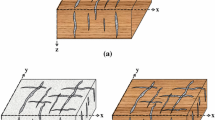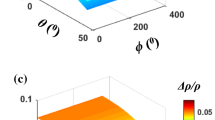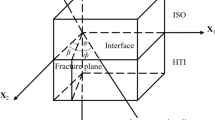Abstract
Geological and geophysical data acquired from naturally fractured hydrocarbon reservoirs usually exhibit the presence of multiple sets of fractures. Two different nonorthorhombic sets of fractures embedded in isotropic background rocks can reveal the anisotropic characteristics of monoclinic symmetry with a horizontal symmetry plane. Here, we focus on the modeling and inversion of the effective elastic properties in fractured reservoirs with monoclinic symmetry induced by a set of horizontal fractures and a set of tilted fractures with rotationally invariant properties embedded in purely isotropic host rock. To facilitate the seismic characterization of fractured reservoirs with monoclinic symmetry, we introduce two sets of fracture weakness parameters to replace the Thomsen-type anisotropic parameters and describe these two nonorthogonal sets of rotationally invariant fractures. With the incident and reflected P wave in such a monoclinic anisotropic medium, we perform the seismic characterization of two nonorthogonal sets of rotationally invariant fractures based on the reflected amplitudes variation with offset and azimuth (AVOAz). Using the linear-slip theory, we first derive the effective elastic stiffness tensor as a function of background isotropic elastic moduli, normal and shear weakness parameters of horizontal and tilted fractures, and the dip angle. We then derive the first-order perturbations in elastic stiffness tensor and formulate the linearized PP-wave reflection coefficient based on the seismic scattering theory. Next, we propose a robust AVOAz inversion approach to characterize these two nonorthogonal fractures with rotationally invariant fractures. Finally, synthetic and real data examples are used to demonstrate that the background elastic moduli and fracture properties can be reasonably estimated using the azimuthal seismic reflected amplitudes. The new formulation and inversion approach may provide us a useful tool to characterize the naturally fractured reservoirs with monoclinic symmetry induced by horizontal and tilted fractures in a more reasonable manner than previous method.





















Similar content being viewed by others
References
Bachrach R (2015) Uncertainty and nonuniqueness in linearized AVAZ for orthorhombic media. Lead Edge 34(9):1048–1056. https://doi.org/10.1190/tle34091048.1
Bachrach R, Sengupta M, Salama A, Miller P (2009) Reconstruction of the layer anisotropic elastic parameter and high resolution fracture characterization from P-wave data: a case study using seismic inversion and Bayesian rock physics parameter estimation. Geophys Prospect 57(2):253–262. https://doi.org/10.1111/j.1365-2478.2008.00768.x
Bakulin A, Grechka V, Tsvankin I (2000a) Estimation of fracture parameters from refection seismic data—part I: HTI model due to a single fracture set. Geophysics 65(6):1788–1802. https://doi.org/10.1190/1.1444863
Bakulin A, Grechka V, Tsvankin I (2000b) Estimation of fracture parameters from reflection seismic data—part II: fractured models with orthorhombic symmetry. Geophysics 65(6):1803–1817. https://doi.org/10.1190/1.1444864
Bakulin A, Grechka V, Tsvankin I (2000c) Estimation of fracture parameters from reflection seismic data—part III: fractured models with monoclinic symmetry. Geophysics 65(6):1818–1830. https://doi.org/10.1190/1.1444865
Bakulin A, Grechka V, Tsvankin I (2002) Seismic inversion for the parameters of two orthogonal fracture sets in a VTI background medium. Geophysics 67(1):292–299. https://doi.org/10.1190/1.1451801
Chen H, Zhang G (2017) Estimation of dry fracture weakness, porosity, and fluid modulus using observable seismic reflection data in a gas-bearing reservoir. Surv Geophys 38(3):651–678. https://doi.org/10.1007/s10712-017-9410-x
Chen H, Chen T, Innanen KA (2020) Estimating tilted fracture weaknesses from azimuthal differences in seismic amplitude data. Geophysics 85(3):R135–R146. https://doi.org/10.1190/geo2018-0199.1
Downton JE, Roure B (2015) Interpreting azimuthal Fourier coefficients for anisotropic and fracture parameters. Interpretation 3(3):ST9–ST27. https://doi.org/10.1190/INT-2014-0235.1
Far ME (2011) Seismic characterization of naturally fractured reservoirs: Ph.D. dissertation, University of Houston
Farra V, Psencik I, Jilek P (2016) Weak-anisotropy moveout approximations for P-waves in homogenous layers of monoclinic or higher anisotropy symmetries. Geophysics 81(2):C17–C37. https://doi.org/10.1190/geo2015-0223.1
Grechka V, Tsvankin I (1998) 3-D description of normal moveout in anisotropic inhomogeneous media. Geophysics 63:1079–1092. https://doi.org/10.1190/1.1444386
Grechka V, Tsvankin I (2003) Feasibility of seismic characterization of multiple fracture sets. Geophysics 68:1399–1407. https://doi.org/10.1190/1.1598133
Grechka V, Contreras P, Tsvankin I (2000) Inversion of normal moveout for monoclinic media. Geophys Prospect 48:577–602. https://doi.org/10.1046/j.1365-2478.2000.00200.x
Grechka V, Bakulin A, Tsvankin I (2003) Seismic characterization of vertical fractures described as general linear-slip interfaces. Geophys Prospect 51:117–130. https://doi.org/10.1046/j.1365-2478.2003.00358.x
Hsu CJ, Schoenberg M (1993) Elastic waves through a simulated fractured medium. Geophysics 58(7):964–977. https://doi.org/10.1190/1.1443487
Hudson JA (1980) Overall properties of a cracked solid. In: Mathematical proceedings of the Cambridge philosophical society. Cambridge University Press, pp 371–384
Hudson JA (1981) Wave speeds and attenuation of elastic waves in material containing cracks. Geophys J Int 64(1):133–150. https://doi.org/10.1111/j.1365-246x.1981.tb02662.x
Ivanov Y, Stovas A (2017) Weak-anisotropy approximation for P-wave reflection coefficient at the boundary between two tilted transversely isotropic media. Geophys Prospect 65:485–502. https://doi.org/10.1111/1365-2478.12436
Jin S, Stovas A (2020) Reflection and transmission approximations for monoclinic media with a horizontal symmetry plane. Geophysics 85(1):C13–C36. https://doi.org/10.1190/geo2019-0240.1
Kachanov M (1980) Continuum model of medium with cracks. J Eng Mech Div 106:1039–1051. https://doi.org/10.1061/JMCEA3.0002642
Nelson RA (1985) Geologic analysis of naturally fractured reservoirs. Gulf Publishing Company, Houston
Pan X, Zhang G (2018) Model parameterization and PP-wave amplitude versus angle and azimuth (AVAZ) direct inversion for fracture quasi-weaknesses in weakly anisotropic elastic media. Surv Geophys 39(5):937–964. https://doi.org/10.1007/s10712-018-9481-3
Pan X, Zhang G (2019) Fracture detection and fluid identification based on anisotropic Gassmann equation and linear-slip model. Geophysics 84(1):R85–R98. https://doi.org/10.1190/geo2018-0255.1
Pan X, Zhang G, Yin X (2017) Azimuthally anisotropic elastic impedance inversion for fluid indicator driven by rock physics. Geophysics 826:C211–C227. https://doi.org/10.1190/geo2017-0191.1
Pan X, Zhang G, Yin X (2018) Azimuthal seismic amplitude variation with offset and azimuth inversion in weakly anisotropic media with orthorhombic symmetry. Surv Geophys 39(1):99–123. https://doi.org/10.1007/s10712-017-9434-2
Pan X, Li L, Zhou S, Zhang G, Liu J (2021) Azimuthal amplitude variation with offset parameterization and inversion for fracture weaknesses in tilted transversely isotropic media. Geophysics 86(1):C1–C18. https://doi.org/10.1190/geo2019-0215.1
Pšenčik I, Gajewski D (1998) Polarization, phase velocity and NMO velocity of qP waves in arbitrary weakly anisotropic media. Geophysics 63:1754–1766. https://doi.org/10.1190/1.1444470
Pšenčík I, Martins JL (2001) Properties of weak contrast PP reflection/transmission coefficients for weakly anisotropic elastic media. Studia Geophysica et Geodaetica 45(2):176–199. https://doi.org/10.1023/A:1021868328668
Pšenčik I, Vavryčuk V (1998) Weak contrast PP-wave displacement R/T coefficients in weakly anisotropic elastic media. Pure Appl Geophys 151:699–718. https://doi.org/10.1007/s000240050137
Reiss LH (1980) The reservoir engineering aspects of fractured formations. Editions Technip, Paris
Rüger A (1997) P-wave reflection coefficients for transversely isotropic models with vertical and horizontal axis of symmetry. Geophysics 62(3):713–722. https://doi.org/10.1190/1.1444181
Rüger A (1998) Variation of P-wave reflectivity with offset and azimuth in anisotropic media. Geophysics 63(3):935–947. https://doi.org/10.1190/1.1444405
Sayers CM (1998) Misalignment of the orientation of fractures and the principal axes for P and S-waves in rocks containing multiple non-orthogonal fracture sets. Geophys J Int 133:459–466. https://doi.org/10.1046/j.1365-246X.1998.00507.x
Sayers CM (2009) Seismic characterization of reservoirs containing multiple fracture sets. Geophys Prospect 57(2):187–192. https://doi.org/10.1111/j.1365-2478.2008.00766.x
Sayers CM, Dean S (2001) Azimuth-dependent AVO in reservoirs containing non-orthogonal fracture sets. Geophys Prospect 49(1):100–106. https://doi.org/10.1046/j.1365-2478.2001.00236.x
Schoenberg M, Douma J (1988) Elastic wave propagation in media with parallel fractures and aligned cracks. Geophys Prospect 36(6):571–590. https://doi.org/10.1111/j.1365-2478.1988.tb02181.x
Schoenberg M, Helbig K (1997) Orthorhombic media: modeling elastic wave behavior in a vertically fractured earth. Geophysics 62(6):1954–1974. https://doi.org/10.1190/1.1444297
Schoenberg M, Sayers CM (1995) Seismic anisotropy of fractured rock. Geophysics 60(1):204–211. https://doi.org/10.1190/1.1443748
Sevostianov I, Kachanov M (1999) Compliance tensors of ellipsoidal inclusions. Int J Fract 96:3–7. https://doi.org/10.1023/A:1018712913071
Shaw RK, Sen MK (2004) Born integral, stationary phase and linearized reflection coefficients in weak anisotropic media. Geophys J Int 158(1):225–238. https://doi.org/10.1111/j.1365-246X.2004.02283.x
Shaw RK, Sen MK (2006) Use of AVOA data to estimate fluid indicator in a vertically fractured media. Geophysics 71(3):C15–C24. https://doi.org/10.1190/1.2194896
Stovas A (2021) On parameterization in monoclinic media with a horizontal symmetry plane. Geophysics 86(1):C37–C49. https://doi.org/10.1190/geo2020-0301.1
Tsvankin I (1997) Anisotropic parameters and P-wave velocity for orthorhombic media. Geophysics 62(40):1292–1309. https://doi.org/10.1190/1.1444231
Tsvankin I (2001) Seismic signatures and analysis of reflection data in anisotropic media. Pergamon, New York
Tsvankin I, Grechka V (2011) Seismology of azimuthally anisotropic media and seismic fracture characterization. SEG
Wang H, Peng S, Du W (2017) Azimuthal AVO for tilted TI medium. Geophysics 82(1):C21–C33. https://doi.org/10.1190/geo2015-0430.1
Wang P, Chen X, Li J, Wang B (2020) Accurate porosity prediction for tight sandstone reservoir: a case study from North China. Geophysics 85(2):B35–B47. https://doi.org/10.1190/geo2018-0852.1
Wang P, Chen X, Li X, Cui Y, Li J, Wang B (2022) Analysis and estimation of an inclusion-based effective fluid modulus for tight gas-bearing sandstone reservoirs. IEEE Trans Geosci Remote Sens 60(4502710):1–10. https://doi.org/10.1109/TGRS.2021.3099134
Zhang G, Li L, Pan X, Li H, Liu J, Han L (2020) Azimuthal Fourier coefficient inversion for horizontal and vertical fracture characterization in weakly orthorhombic media. Geophysics 85(6):C199–C214. https://doi.org/10.1190/geo2019-0797.1
Acknowledgements
We would like to express our gratitude to the sponsorship of the National Natural Science Foundation of China (42004107, 42130810, U19B2008, 42074136) and the Natural Science Foundation of Hunan Province (2021JJ30814) for the funding in this research. We also thank the anonymous reviewers for their constructive suggestions.
Author information
Authors and Affiliations
Corresponding author
Additional information
Publisher's Note
Springer Nature remains neutral with regard to jurisdictional claims in published maps and institutional affiliations.
Appendices
Appendix 1: Perturbations in Stiffness Matrix of a Monoclinic Anisotropic Medium
The perturbations in the stiffness matrix of such a monoclinic anisotropic medium can be derived as
with
where \(\Delta M_{{\text{b}}} = M_{{{\text{b}}2}} - M_{{{\text{b1}}}}\) and \(\Delta \mu_{{\text{b}}} = \mu_{{{\text{b2}}}} - \mu_{{{\text{b1}}}}\) represent the changes in P- and S-wave moduli across the reflection interface, respectively, and \(\Delta \lambda_{{\text{b}}} = \lambda_{{{\text{b2}}}} - \lambda_{{{\text{b1}}}}\) also represent the changes in the first Lamé parameter across the reflection interface; \(\Delta \delta_{{\text{N}}}^{{{\text{Hori}}.}} = \delta_{{{\text{N2}}}}^{{{\text{Hori}}{.}}} - \delta_{{{\text{N1}}}}^{{{\text{Hori}}{.}}}\) and \(\Delta \delta_{{\text{T}}}^{{{\text{Hori}}{.}}} = \delta_{{{\text{T2}}}}^{{{\text{Hori}}{.}}} - \delta_{{{\text{T1}}}}^{{{\text{Hori}}{.}}}\) represent the changes in normal and shear weaknesses of horizontal fractures across the reflection interface, respectively; \(\Delta \delta_{{\text{N}}}^{{{\text{Tilted}}}} = \delta_{{{\text{N2}}}}^{{{\text{Tilted}}}} - \delta_{{{\text{N1}}}}^{{{\text{Tilted}}}}\) and \(\Delta \delta_{{\text{T}}}^{{{\text{Tilted}}}} = \delta_{{{\text{T2}}}}^{{{\text{Tilted}}}} - \delta_{{{\text{T1}}}}^{{{\text{Tilted}}}}\) represent the changes in normal and shear weaknesses of tilted fractures across the reflection interface, respectively.
Appendix 2: Derivation of Linearized PP-Wave Reflection Coefficient of a Monoclinic Anisotropic Medium
Considering the opposite relations between η15 and η51, η25 and η52, η35 and η53, η46 and η64, the PP-wave reflection coefficient of a monoclinic anisotropic medium can be derived as
Substituting Eq. (12) into (13), we can get
Appendix 3: PP-Wave Reflection Coefficient in VTI, TTI and Orthorhombic Media
When there are no tilted fractures in such a monoclinic model, the PP-wave reflection coefficient can generate the reflection coefficient of a VTI medium as
When there are no horizontal fractures in such a monoclinic model, the PP-wave reflection coefficient can generate the reflection coefficient of a TTI medium as
Equation (16) is consistent with the derived reflection coefficient by Chen et al. (2020) and Pan et al. (2021).
When the dip angle of tilted fractures is 90° in such a monoclinic model, the PP-wave reflection coefficient can generate the reflection coefficient of an orthorhombic medium as
Equation (17) is consistent with the derived reflection coefficient by Zhang et al. (2020).
Rights and permissions
About this article
Cite this article
Pan, X., Lu, C., Zhang, G. et al. Seismic Characterization of Naturally Fractured Reservoirs with Monoclinic Symmetry Induced by Horizontal and Tilted Fractures from Amplitude Variation with Offset and Azimuth. Surv Geophys 43, 815–851 (2022). https://doi.org/10.1007/s10712-022-09709-0
Received:
Accepted:
Published:
Issue Date:
DOI: https://doi.org/10.1007/s10712-022-09709-0




